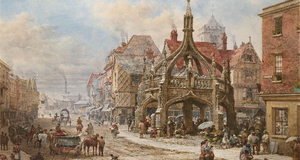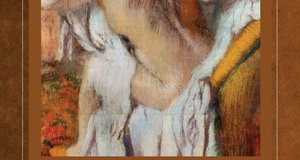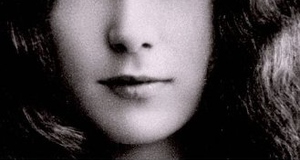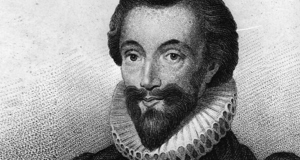"Goblin Market:" Renunciation and Redemption in Christina Rossetti's Narrative Poem
By
2014, Vol. 6 No. 01 | pg. 2/2 | « It is Laura who must “die” and return to “life” in order to be redeemed, not Lizzie as Christ. In this redemptive process, Laura gains freedom from the goblins’ power over her through animal imagery. She appears “like the mane of horses in their flight, / Or like an eagle when she stems the light / . . . Or like a caged thing freed, / Or like a flying flag when armies run” (ll. 502‑03, 505‑06). By gorging on goblin juice for one last time she symbolically dies: “like a lightning‑stricken mast, / Like a wind‑uprooted tree / . . . Like a foam‑topped watersprout / Cast down headlong in the sea” (ll. 516‑17, 519‑20). This process is necessary so she can return to her old life. Such “death” produces a resurrection, a “life out of death” (l. 524) in which Laura awakes “as from a dream” (l. 537), with her health and beauty restored (Grass 375). This resurrection contains imagery of the natural world at sunrise (ll. 530‑36) reminiscent of Easter, the penultimate resurrection. The final scene in the poem finds Laura and Lizzie in the happy, domestic roles of wives and mothers, educating their children on the dangers of goblins, with Laura praising her Christ‑like sister for redeeming her. Laura may appear to be returning to her original domestic state before her goblin fruit experience, but her domestic life after her redemption is not the same as the pre‑goblin one. It is only after Laura is “cured” of her desire for goblin fruit that both she and Lizzie become “wives / With children of their own; / Their mother‑lives beset with fears, / Their lives bound up in tender lives” (ll. 544‑47). She and Lizzie are not sexual objects to be abused, but wives and mothers who have learned to support one another in crises. Laura’s return to life, health, and domesticity is not to a pre‑goblin state of living in nature but to a post‑goblin one of appreciating that innocence of being one with nature, in which Laura can comprehend and cherish her sister’s sacrifice. Laura warns her children of goblin dangers because she remembers the fruit experience. It allows her to physically and spiritually mature in order to take on adult responsibilities, not avoid them. Whether Laura’s return to a state of domesticity is to an old world or new has been highly debated. According to Antony Harrison such “dualisms, contraries, and oppositions” that exist in the poem “open up a space for decoding the world” and “encoding a new [one]. . . .This potential is . . . truncated . . . by a deliberate reintroduction of the conventional world and [its] expectations” (18). Elizabeth Helsinger concurs, stating, “Lizzie and Laura triumph over the market only to withdraw from it” (907). However, the poem does not support such a reading. Laura’s “old lifestyle” is “destroyed”; her “rebirth . . . does not repudiate the experience of sin” (Eberle 192, 195). There has been a change; the potential for a new world expands. Rossetti expects readers to see Laura’s “new” world and beginning in this light because of Easter imagery. In this new world, Laura can warn her children of the dangers of goblins, which she could not do before without experiencing such dangers firsthand. This new world also finds Laura viewing her sister as a “savior” and “friend,” which was not possible before her goblin fruit experience.Although Laura and Lizzie return to a quiet, domestic life as wives and mothers, men as husbands and fathers are conspicuously absent. It is Lizzie who “st[ands] / In deadly peril” (l. 557‑58) to save Laura from “wicked, quaint fruit‑merchant men” (l. 553), not Laura’s husband. It is Lizzie who “win[s] the fiery antidote” (l. 559). She is praised, again as a Christ figure, for being both an earthly, and spiritual, friend and guide on life’s journey, not Laura’s husband: “‘For there is no friend like a sister / . . . To cheer one on the tedious way, / To fetch one if one goes astray,/ To lift one if one totters down, / To strengthen whilst one stands’” (ll. 562, 564‑67). Rossetti’s portrayal of Lizzie as a female Christ overturns the traditional view of the husband as symbolic “savior” and “Christ.” As Lynda Palazzo and Diane D’Amico note, such a portrayal is subversive. The final scene is a form of renunciation, but what it consists of is not Laura’s repudiation of her sexuality to embrace the higher, spiritual realm. Nor is she renouncing her feminist nature to embrace Victorian domesticity. Instead, Laura has learned to renounce her carnal desires so she can embrace her sexuality in its pure, proper sphere: marriage, a domestic state uniting sexual and spiritual. Laura’s return does not force an unequal dichotomy between her earthly and spiritual natures, in which she must choose one and renounce the other; instead, it unites the two natures. Rossetti is often preoccupied in her poetry with death and the afterlife, but not here; the focus is on how to make Lizzie and Laura’s earthly lives better (Eberle 176). Such domesticity is “a sign of solidarity and hope for the future” (Palazzo 22). The poem ends on a positive note, for it “gives women money, fruit, pleasure, children, and . . . laughter” (Leighton 140). Thomas Carlyle notes, “It is only with Renunciation . . . that life, properly speaking, can be said to begin” (145). Christina Rossetti’s “Goblin Market” is not a story of renouncing sensual desires to embrace the spiritual nature. Neither is it a story of renouncing modern views of women to return to a life of traditional, Victorian domesticity. Instead, “Goblin Market” is the story of two sisters who have learned to renounce their carnal sensuality, represented by goblin men and fruit, in order to embrace a purer form of that sensuality in the Victorian context of marriage. According to Rossetti, marriage is the highest, earthly union of sexual passion and spiritual oneness. She portrays Lizzie as Christ in her redemption of Laura to demonstrate the multiple meanings of renunciation and the sanctity of marriage: the perfect union of body and soul. ReferencesBentley, D. M. R. “The Meretricious and the Meritorious in Goblin Market: A Conjecture and an Analysis.” The Achievement of Christina Rossetti. Ed. David Kent. Ithaca: Cornell UP, 1987. 57‑81. Carlyle, Thomas. Sartor Resartus. 1834. Eds. Kerry McSweeney and Peter Sabor. Oxford, NY: Oxford UP, 1987. D’Amico, Diane. Christina Rossetti: Faith, Gender, and Time. Baton Rouge: Louisiana State UP, 1999. DeVitis, A. A. “‘Goblin Market’: Fairy Tale and Reality.” Journal of Popular Culture 1.4 (1968): 418‑26. Eberle, Roxanne. Chastity and Transgression in Women’s Writing, 1792‑1897: Interrupting the Harlot’s Progress. London: Palgrave, 2002. Gilbert, Sandra, and Susan Gubar. The Madwoman in the Attic: The Woman Writer and the Nineteenth‑Century Literary Imagination. 2nd ed. New Haven: Yale UP, 2000. Grass, Sean C. “Nature’s Perilous Variety in Rossetti’s ‘Goblin Market.’” Nineteenth‑Century Literature 51.3 (1996): 356‑76. <http://www.jstor.org> 24 Feb. 2005 Harrison, Antony. Christina Rossetti in Context. Chapel Hill: U of North Carolina P, 1988. Helsinger, Elizabeth K. “Consumer Power and the Utopia of Desire: Christina Rossetti’s ‘Goblin Market.’” ELH 58.4 (1991): 903‑33. <http://www.jstor.org> 24 Feb. 2005 The Holy Bible: New International Version. Grand Rapids, MI: Zondervan, 1996. Leighton, Angela. Victorian Women Poets: Writing Against the Heart. Victorian Literature and Culture Series. Eds. Karen Chase, Jerome J. McGann, and Herbert Tucker. Charlottesville: UP of Virginia, 1992. Mermin, Dorothy. “Heroic Sisterhood in ‘Goblin Market.’” Victorian Poetry 21.2 (1983): 107‑18. Packer, Lona Mosk. “Symbol and Reality in Christina Rossetti’s ‘Goblin Market.’” PMLA 73.4 (1958): 375‑85. <http://www.jstor.org> 24 Feb. 2005 Palazzo, Lynda. Christina Rossetti’s Feminist Theology. Cross‑Currents in Religion and Culture. Eds. Elisabeth Jay and David Jasper. London: Palgrave, 2002. Rossetti, Christina. “Goblin Market.” Goblin Market and Other Poems. 1862. The Complete Poems of Christina Rossetti: A Varorium Edition. Ed. R. W. Crump. Vol. 1. Baton Rouge: Louisiana State UP, 1979. 11‑26. Suggested Reading from Inquiries Journal
Inquiries Journal provides undergraduate and graduate students around the world a platform for the wide dissemination of academic work over a range of core disciplines. Representing the work of students from hundreds of institutions around the globe, Inquiries Journal's large database of academic articles is completely free. Learn more | Blog | Submit Latest in Literature |


















